Diploma of Nursing HLTAAP002 Assignment: Body Systems and Functions
VerifiedAdded on 2022/08/25
|15
|4219
|19
Homework Assignment
AI Summary
This assignment provides a comprehensive overview of human anatomy and physiology, focusing on the HLTAAP002 unit of competency for a Diploma of Nursing. It covers the structure and function of human cells and skeletal muscle tissue, including cellular adaptations like hyperplasia, hypertrophy, atrophy, and metaplasia. The assignment explores various life processes such as organization, metabolism, nutrition, biological maturation, inheritance, and aging. It delves into the six levels of structural organization of the human body and the concept of homeostasis, including homeostatic imbalance and disease. Furthermore, it details the structure and function of major body systems, including the cardiovascular, respiratory, muscular, skeletal, endocrine, nervous, digestive, urinary, reproductive, integumentary, and lymphatic systems, along with their interactions. The assignment also addresses the immune system's lines of defense and the senses of vision, hearing, smell, and taste, including the associated organs and processes. Finally, it includes a table summarizing common disorders associated with different organ systems.

HLT54115 Diploma of Nursing
Unit of competency
HLTAAP002 Confirm physical health status
1. Briefly describe the overall structure and functions of the following components of the
human body.
a) Overall structure and functions of a human cell
Structure: the human body cell is composed of many cells. They provide the key structure for
the body, through intake of nutrients, energy process and other special functions. They
many structures such as organelles, lysozomes and other parts
Functions: Cells offers crucial support and performance of body activities. The presence of
specialized organelles performs various functions key in the overall body processes.
b) Overall structure and functions of skeletal muscle tissue:
Structure: It is made up of three key major muscle tissues, forming a striated muscle tissue.
Functions: Most of the skeletal muscles are used in attaching bones through collagen fibre
bundles referred to as tendons. (Gray et al., 2018)
2. Briefly describe the following four (4) major types of cellular adaptation.
a) Hyperplasia: Refers to the enlargement of organ or a tissue due to an increase in cells
reproduction.
b) Hypertrophy: Refers to the increase in the muscles growth specially the muscular size
more commonly during exercise.
c) Atrophy: Refers to the gradual decline of a body tissue or organ due to cell degeneration.
d) Metaplasia: Refers to abnormal changes in the tissue nature of cells or an organ.
Unit of competency
HLTAAP002 Confirm physical health status
1. Briefly describe the overall structure and functions of the following components of the
human body.
a) Overall structure and functions of a human cell
Structure: the human body cell is composed of many cells. They provide the key structure for
the body, through intake of nutrients, energy process and other special functions. They
many structures such as organelles, lysozomes and other parts
Functions: Cells offers crucial support and performance of body activities. The presence of
specialized organelles performs various functions key in the overall body processes.
b) Overall structure and functions of skeletal muscle tissue:
Structure: It is made up of three key major muscle tissues, forming a striated muscle tissue.
Functions: Most of the skeletal muscles are used in attaching bones through collagen fibre
bundles referred to as tendons. (Gray et al., 2018)
2. Briefly describe the following four (4) major types of cellular adaptation.
a) Hyperplasia: Refers to the enlargement of organ or a tissue due to an increase in cells
reproduction.
b) Hypertrophy: Refers to the increase in the muscles growth specially the muscular size
more commonly during exercise.
c) Atrophy: Refers to the gradual decline of a body tissue or organ due to cell degeneration.
d) Metaplasia: Refers to abnormal changes in the tissue nature of cells or an organ.
Paraphrase This Document
Need a fresh take? Get an instant paraphrase of this document with our AI Paraphraser

(Cooper et al., 2018)
3. Briefly describe the following life processes in your own words.
a) Organisation: Refers to the ability of working collaboratively together for a specific
purpose.
b) Processes of metabolism: Metabolisms refers to the sum of all chemical activity which are
entailed in the catabolism and anabolisms in the body.
c) Nutrition: This is the overall process of providing and obtaining food key for health and
growth purpose
d) Biological maturation: Biological maturation refers to the marked process towards adult
state. All body organs ranging from tissues to whole body matures however at
different times and rates.
e) Inheritance: This refers to the mechanisms of one class acquiring property rights of
another class.
f) Ageing: Is the general process by which structure and functions aspect changes in
organism undergo after a period of time, leading to decline in physiological functions.
(Forbes, H. and Watt, 2015)
4. Briefly describe the six (6) levels of structural organisation of the human body in order
from the smallest structural unit to the largest.
- The six levels begin with chemical levels where is a combination of various chemical
ingredients leading to development of cellular aspects. They agglomerate to form
tissues which perform certain specific function. Group of tissues leads to development
of an organ such as kidney which have fundamental function in the body. Group of
organs leads to an organ system linking various organs and lastly an organism level
which forms a creature. (Bianconi et al., 2013)
5. The human body strives to adjust to conditions that are optimal for survival. Answer the
following questions on homeostasis.
a) Briefly describe the concept of homeostasis in your own words.
3. Briefly describe the following life processes in your own words.
a) Organisation: Refers to the ability of working collaboratively together for a specific
purpose.
b) Processes of metabolism: Metabolisms refers to the sum of all chemical activity which are
entailed in the catabolism and anabolisms in the body.
c) Nutrition: This is the overall process of providing and obtaining food key for health and
growth purpose
d) Biological maturation: Biological maturation refers to the marked process towards adult
state. All body organs ranging from tissues to whole body matures however at
different times and rates.
e) Inheritance: This refers to the mechanisms of one class acquiring property rights of
another class.
f) Ageing: Is the general process by which structure and functions aspect changes in
organism undergo after a period of time, leading to decline in physiological functions.
(Forbes, H. and Watt, 2015)
4. Briefly describe the six (6) levels of structural organisation of the human body in order
from the smallest structural unit to the largest.
- The six levels begin with chemical levels where is a combination of various chemical
ingredients leading to development of cellular aspects. They agglomerate to form
tissues which perform certain specific function. Group of tissues leads to development
of an organ such as kidney which have fundamental function in the body. Group of
organs leads to an organ system linking various organs and lastly an organism level
which forms a creature. (Bianconi et al., 2013)
5. The human body strives to adjust to conditions that are optimal for survival. Answer the
following questions on homeostasis.
a) Briefly describe the concept of homeostasis in your own words.
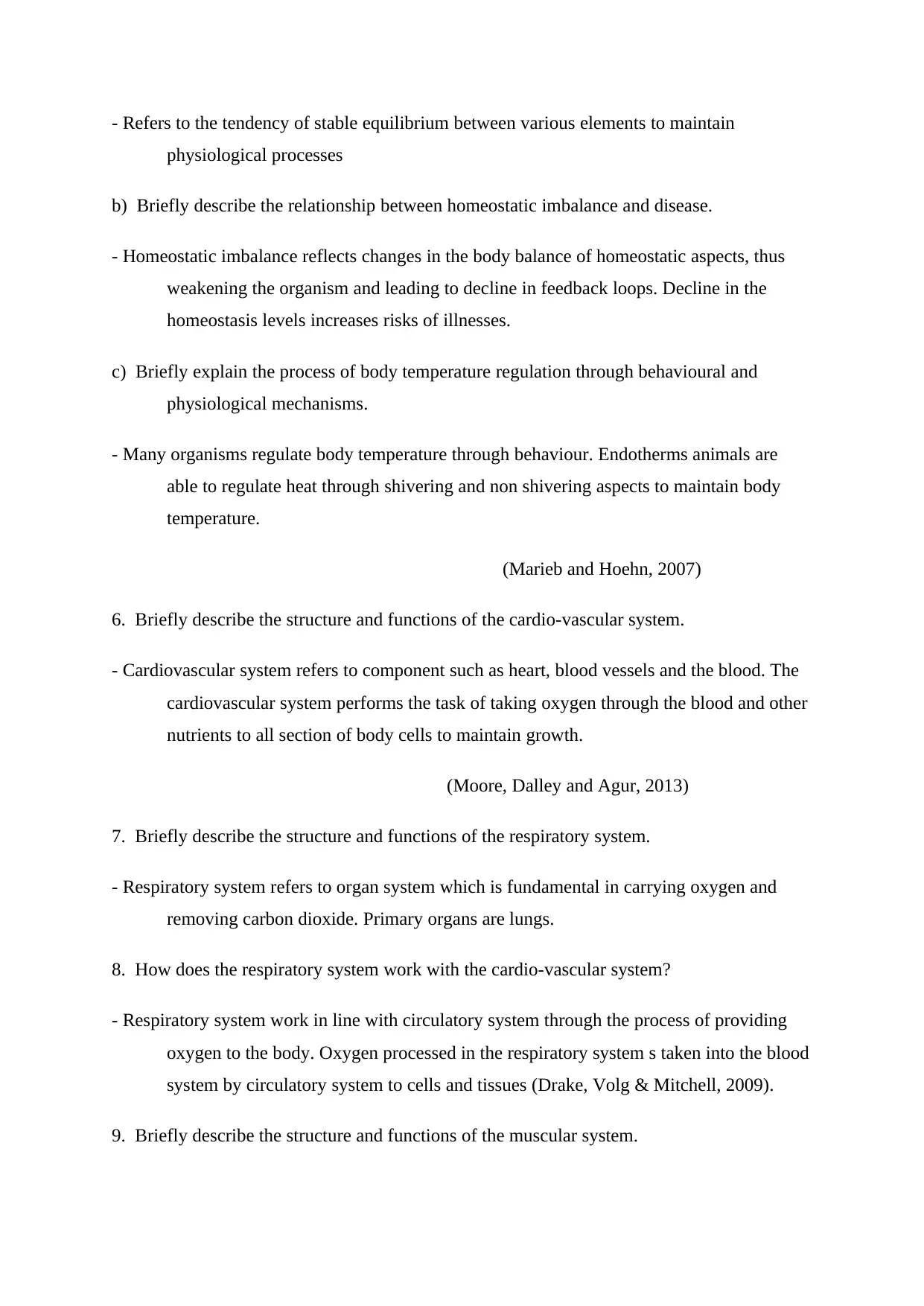
- Refers to the tendency of stable equilibrium between various elements to maintain
physiological processes
b) Briefly describe the relationship between homeostatic imbalance and disease.
- Homeostatic imbalance reflects changes in the body balance of homeostatic aspects, thus
weakening the organism and leading to decline in feedback loops. Decline in the
homeostasis levels increases risks of illnesses.
c) Briefly explain the process of body temperature regulation through behavioural and
physiological mechanisms.
- Many organisms regulate body temperature through behaviour. Endotherms animals are
able to regulate heat through shivering and non shivering aspects to maintain body
temperature.
(Marieb and Hoehn, 2007)
6. Briefly describe the structure and functions of the cardio-vascular system.
- Cardiovascular system refers to component such as heart, blood vessels and the blood. The
cardiovascular system performs the task of taking oxygen through the blood and other
nutrients to all section of body cells to maintain growth.
(Moore, Dalley and Agur, 2013)
7. Briefly describe the structure and functions of the respiratory system.
- Respiratory system refers to organ system which is fundamental in carrying oxygen and
removing carbon dioxide. Primary organs are lungs.
8. How does the respiratory system work with the cardio-vascular system?
- Respiratory system work in line with circulatory system through the process of providing
oxygen to the body. Oxygen processed in the respiratory system s taken into the blood
system by circulatory system to cells and tissues (Drake, Volg & Mitchell, 2009).
9. Briefly describe the structure and functions of the muscular system.
physiological processes
b) Briefly describe the relationship between homeostatic imbalance and disease.
- Homeostatic imbalance reflects changes in the body balance of homeostatic aspects, thus
weakening the organism and leading to decline in feedback loops. Decline in the
homeostasis levels increases risks of illnesses.
c) Briefly explain the process of body temperature regulation through behavioural and
physiological mechanisms.
- Many organisms regulate body temperature through behaviour. Endotherms animals are
able to regulate heat through shivering and non shivering aspects to maintain body
temperature.
(Marieb and Hoehn, 2007)
6. Briefly describe the structure and functions of the cardio-vascular system.
- Cardiovascular system refers to component such as heart, blood vessels and the blood. The
cardiovascular system performs the task of taking oxygen through the blood and other
nutrients to all section of body cells to maintain growth.
(Moore, Dalley and Agur, 2013)
7. Briefly describe the structure and functions of the respiratory system.
- Respiratory system refers to organ system which is fundamental in carrying oxygen and
removing carbon dioxide. Primary organs are lungs.
8. How does the respiratory system work with the cardio-vascular system?
- Respiratory system work in line with circulatory system through the process of providing
oxygen to the body. Oxygen processed in the respiratory system s taken into the blood
system by circulatory system to cells and tissues (Drake, Volg & Mitchell, 2009).
9. Briefly describe the structure and functions of the muscular system.
⊘ This is a preview!⊘
Do you want full access?
Subscribe today to unlock all pages.

Trusted by 1+ million students worldwide
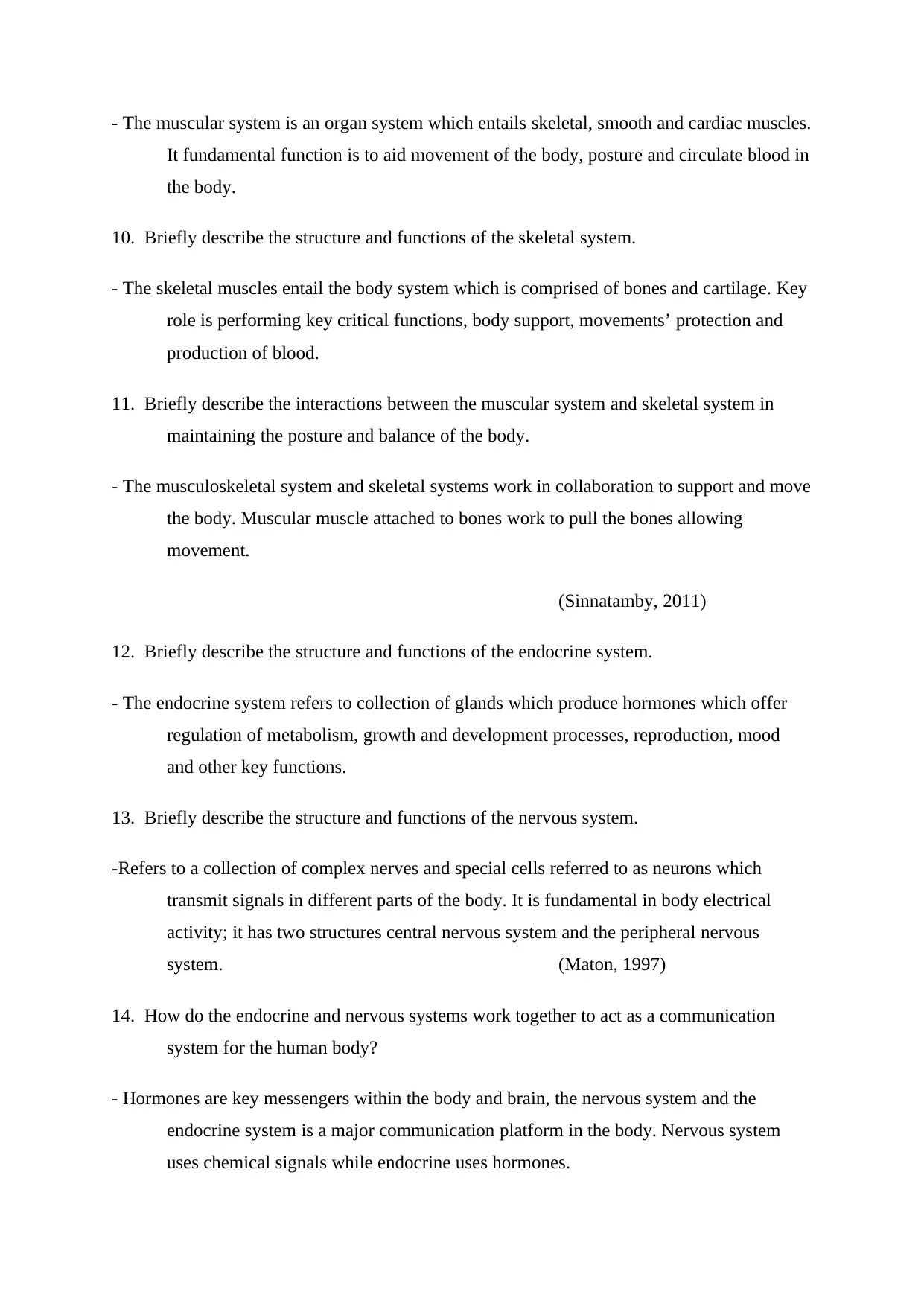
- The muscular system is an organ system which entails skeletal, smooth and cardiac muscles.
It fundamental function is to aid movement of the body, posture and circulate blood in
the body.
10. Briefly describe the structure and functions of the skeletal system.
- The skeletal muscles entail the body system which is comprised of bones and cartilage. Key
role is performing key critical functions, body support, movements’ protection and
production of blood.
11. Briefly describe the interactions between the muscular system and skeletal system in
maintaining the posture and balance of the body.
- The musculoskeletal system and skeletal systems work in collaboration to support and move
the body. Muscular muscle attached to bones work to pull the bones allowing
movement.
(Sinnatamby, 2011)
12. Briefly describe the structure and functions of the endocrine system.
- The endocrine system refers to collection of glands which produce hormones which offer
regulation of metabolism, growth and development processes, reproduction, mood
and other key functions.
13. Briefly describe the structure and functions of the nervous system.
-Refers to a collection of complex nerves and special cells referred to as neurons which
transmit signals in different parts of the body. It is fundamental in body electrical
activity; it has two structures central nervous system and the peripheral nervous
system. (Maton, 1997)
14. How do the endocrine and nervous systems work together to act as a communication
system for the human body?
- Hormones are key messengers within the body and brain, the nervous system and the
endocrine system is a major communication platform in the body. Nervous system
uses chemical signals while endocrine uses hormones.
It fundamental function is to aid movement of the body, posture and circulate blood in
the body.
10. Briefly describe the structure and functions of the skeletal system.
- The skeletal muscles entail the body system which is comprised of bones and cartilage. Key
role is performing key critical functions, body support, movements’ protection and
production of blood.
11. Briefly describe the interactions between the muscular system and skeletal system in
maintaining the posture and balance of the body.
- The musculoskeletal system and skeletal systems work in collaboration to support and move
the body. Muscular muscle attached to bones work to pull the bones allowing
movement.
(Sinnatamby, 2011)
12. Briefly describe the structure and functions of the endocrine system.
- The endocrine system refers to collection of glands which produce hormones which offer
regulation of metabolism, growth and development processes, reproduction, mood
and other key functions.
13. Briefly describe the structure and functions of the nervous system.
-Refers to a collection of complex nerves and special cells referred to as neurons which
transmit signals in different parts of the body. It is fundamental in body electrical
activity; it has two structures central nervous system and the peripheral nervous
system. (Maton, 1997)
14. How do the endocrine and nervous systems work together to act as a communication
system for the human body?
- Hormones are key messengers within the body and brain, the nervous system and the
endocrine system is a major communication platform in the body. Nervous system
uses chemical signals while endocrine uses hormones.
Paraphrase This Document
Need a fresh take? Get an instant paraphrase of this document with our AI Paraphraser
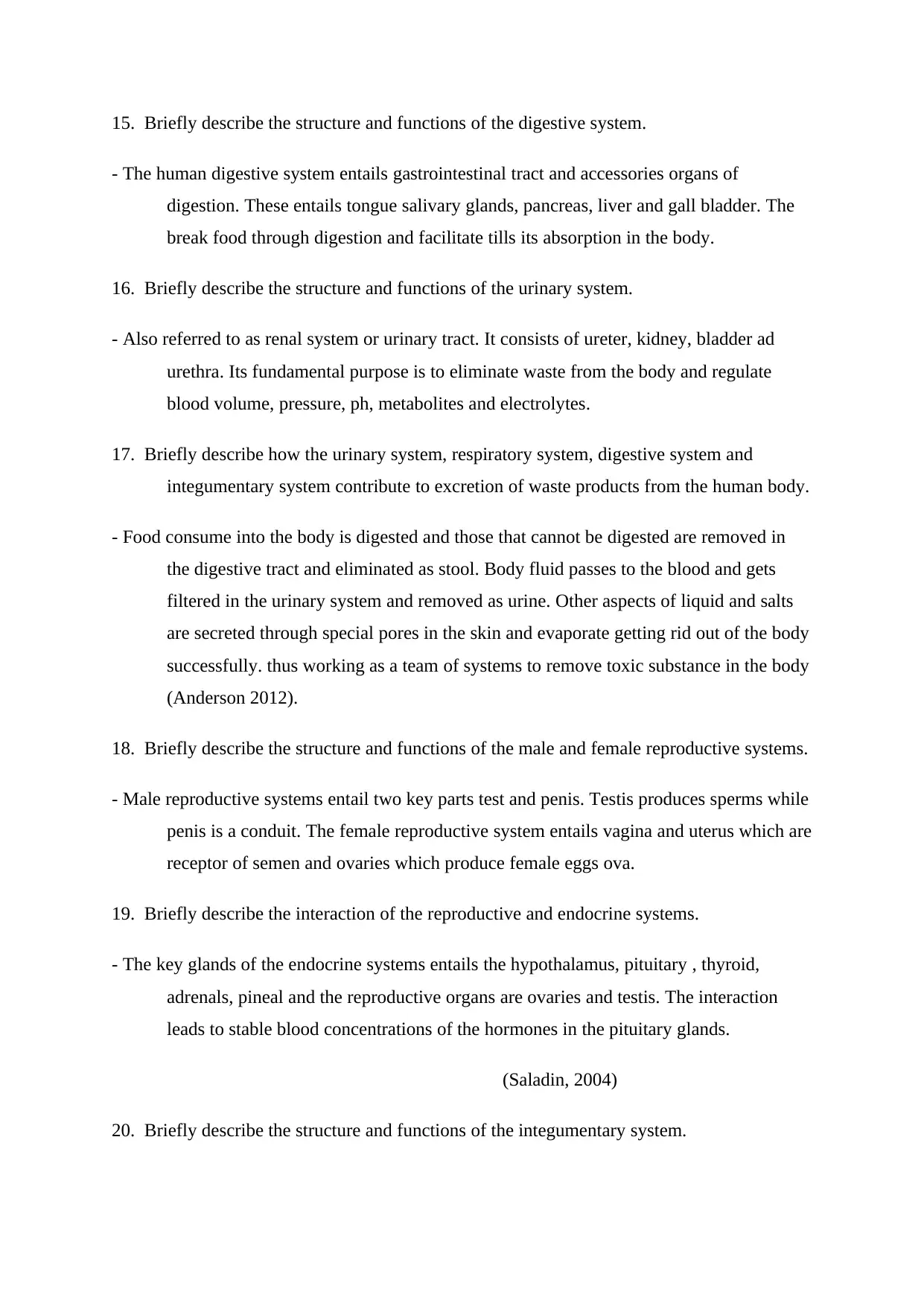
15. Briefly describe the structure and functions of the digestive system.
- The human digestive system entails gastrointestinal tract and accessories organs of
digestion. These entails tongue salivary glands, pancreas, liver and gall bladder. The
break food through digestion and facilitate tills its absorption in the body.
16. Briefly describe the structure and functions of the urinary system.
- Also referred to as renal system or urinary tract. It consists of ureter, kidney, bladder ad
urethra. Its fundamental purpose is to eliminate waste from the body and regulate
blood volume, pressure, ph, metabolites and electrolytes.
17. Briefly describe how the urinary system, respiratory system, digestive system and
integumentary system contribute to excretion of waste products from the human body.
- Food consume into the body is digested and those that cannot be digested are removed in
the digestive tract and eliminated as stool. Body fluid passes to the blood and gets
filtered in the urinary system and removed as urine. Other aspects of liquid and salts
are secreted through special pores in the skin and evaporate getting rid out of the body
successfully. thus working as a team of systems to remove toxic substance in the body
(Anderson 2012).
18. Briefly describe the structure and functions of the male and female reproductive systems.
- Male reproductive systems entail two key parts test and penis. Testis produces sperms while
penis is a conduit. The female reproductive system entails vagina and uterus which are
receptor of semen and ovaries which produce female eggs ova.
19. Briefly describe the interaction of the reproductive and endocrine systems.
- The key glands of the endocrine systems entails the hypothalamus, pituitary , thyroid,
adrenals, pineal and the reproductive organs are ovaries and testis. The interaction
leads to stable blood concentrations of the hormones in the pituitary glands.
(Saladin, 2004)
20. Briefly describe the structure and functions of the integumentary system.
- The human digestive system entails gastrointestinal tract and accessories organs of
digestion. These entails tongue salivary glands, pancreas, liver and gall bladder. The
break food through digestion and facilitate tills its absorption in the body.
16. Briefly describe the structure and functions of the urinary system.
- Also referred to as renal system or urinary tract. It consists of ureter, kidney, bladder ad
urethra. Its fundamental purpose is to eliminate waste from the body and regulate
blood volume, pressure, ph, metabolites and electrolytes.
17. Briefly describe how the urinary system, respiratory system, digestive system and
integumentary system contribute to excretion of waste products from the human body.
- Food consume into the body is digested and those that cannot be digested are removed in
the digestive tract and eliminated as stool. Body fluid passes to the blood and gets
filtered in the urinary system and removed as urine. Other aspects of liquid and salts
are secreted through special pores in the skin and evaporate getting rid out of the body
successfully. thus working as a team of systems to remove toxic substance in the body
(Anderson 2012).
18. Briefly describe the structure and functions of the male and female reproductive systems.
- Male reproductive systems entail two key parts test and penis. Testis produces sperms while
penis is a conduit. The female reproductive system entails vagina and uterus which are
receptor of semen and ovaries which produce female eggs ova.
19. Briefly describe the interaction of the reproductive and endocrine systems.
- The key glands of the endocrine systems entails the hypothalamus, pituitary , thyroid,
adrenals, pineal and the reproductive organs are ovaries and testis. The interaction
leads to stable blood concentrations of the hormones in the pituitary glands.
(Saladin, 2004)
20. Briefly describe the structure and functions of the integumentary system.
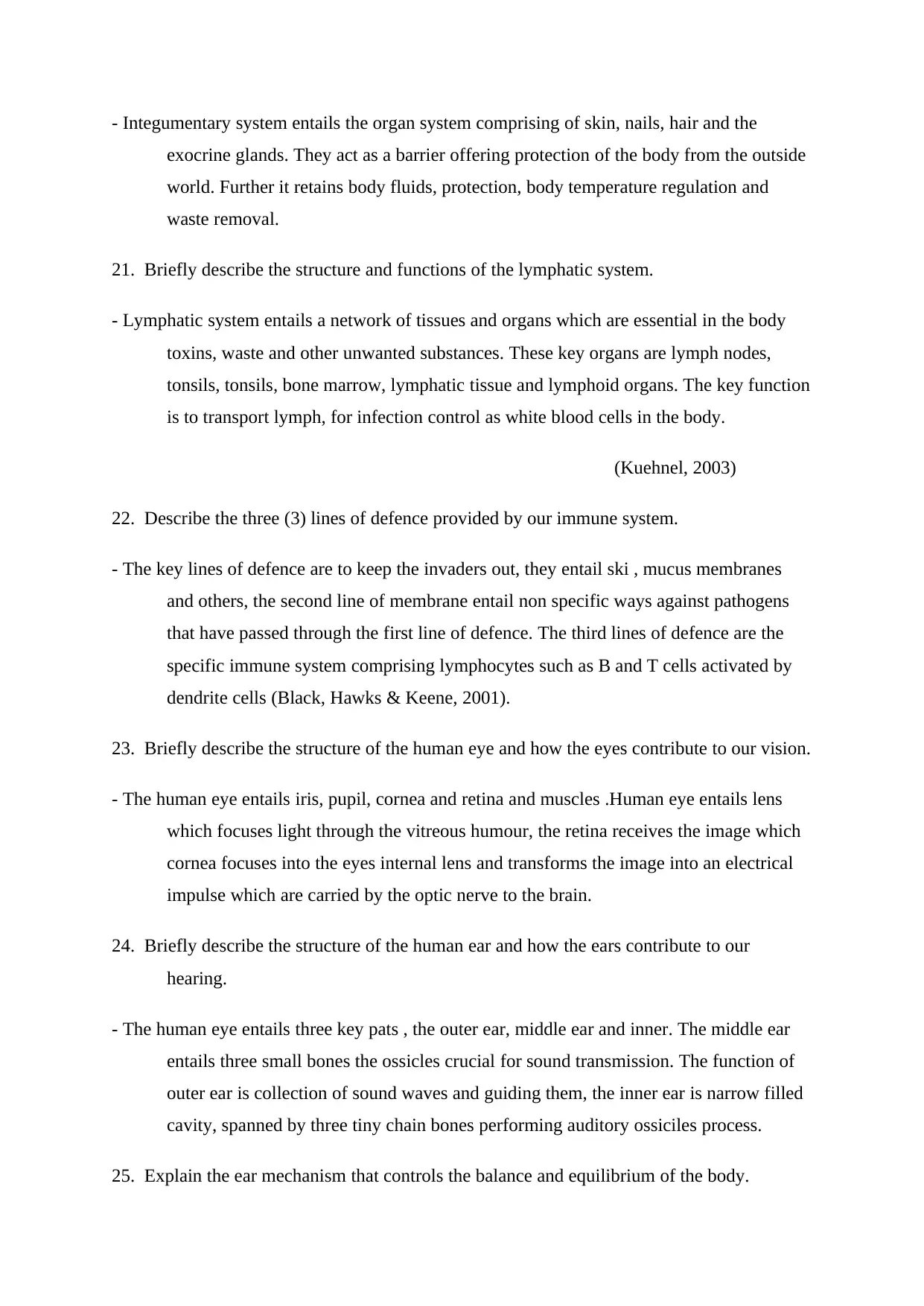
- Integumentary system entails the organ system comprising of skin, nails, hair and the
exocrine glands. They act as a barrier offering protection of the body from the outside
world. Further it retains body fluids, protection, body temperature regulation and
waste removal.
21. Briefly describe the structure and functions of the lymphatic system.
- Lymphatic system entails a network of tissues and organs which are essential in the body
toxins, waste and other unwanted substances. These key organs are lymph nodes,
tonsils, tonsils, bone marrow, lymphatic tissue and lymphoid organs. The key function
is to transport lymph, for infection control as white blood cells in the body.
(Kuehnel, 2003)
22. Describe the three (3) lines of defence provided by our immune system.
- The key lines of defence are to keep the invaders out, they entail ski , mucus membranes
and others, the second line of membrane entail non specific ways against pathogens
that have passed through the first line of defence. The third lines of defence are the
specific immune system comprising lymphocytes such as B and T cells activated by
dendrite cells (Black, Hawks & Keene, 2001).
23. Briefly describe the structure of the human eye and how the eyes contribute to our vision.
- The human eye entails iris, pupil, cornea and retina and muscles .Human eye entails lens
which focuses light through the vitreous humour, the retina receives the image which
cornea focuses into the eyes internal lens and transforms the image into an electrical
impulse which are carried by the optic nerve to the brain.
24. Briefly describe the structure of the human ear and how the ears contribute to our
hearing.
- The human eye entails three key pats , the outer ear, middle ear and inner. The middle ear
entails three small bones the ossicles crucial for sound transmission. The function of
outer ear is collection of sound waves and guiding them, the inner ear is narrow filled
cavity, spanned by three tiny chain bones performing auditory ossiciles process.
25. Explain the ear mechanism that controls the balance and equilibrium of the body.
exocrine glands. They act as a barrier offering protection of the body from the outside
world. Further it retains body fluids, protection, body temperature regulation and
waste removal.
21. Briefly describe the structure and functions of the lymphatic system.
- Lymphatic system entails a network of tissues and organs which are essential in the body
toxins, waste and other unwanted substances. These key organs are lymph nodes,
tonsils, tonsils, bone marrow, lymphatic tissue and lymphoid organs. The key function
is to transport lymph, for infection control as white blood cells in the body.
(Kuehnel, 2003)
22. Describe the three (3) lines of defence provided by our immune system.
- The key lines of defence are to keep the invaders out, they entail ski , mucus membranes
and others, the second line of membrane entail non specific ways against pathogens
that have passed through the first line of defence. The third lines of defence are the
specific immune system comprising lymphocytes such as B and T cells activated by
dendrite cells (Black, Hawks & Keene, 2001).
23. Briefly describe the structure of the human eye and how the eyes contribute to our vision.
- The human eye entails iris, pupil, cornea and retina and muscles .Human eye entails lens
which focuses light through the vitreous humour, the retina receives the image which
cornea focuses into the eyes internal lens and transforms the image into an electrical
impulse which are carried by the optic nerve to the brain.
24. Briefly describe the structure of the human ear and how the ears contribute to our
hearing.
- The human eye entails three key pats , the outer ear, middle ear and inner. The middle ear
entails three small bones the ossicles crucial for sound transmission. The function of
outer ear is collection of sound waves and guiding them, the inner ear is narrow filled
cavity, spanned by three tiny chain bones performing auditory ossiciles process.
25. Explain the ear mechanism that controls the balance and equilibrium of the body.
⊘ This is a preview!⊘
Do you want full access?
Subscribe today to unlock all pages.

Trusted by 1+ million students worldwide
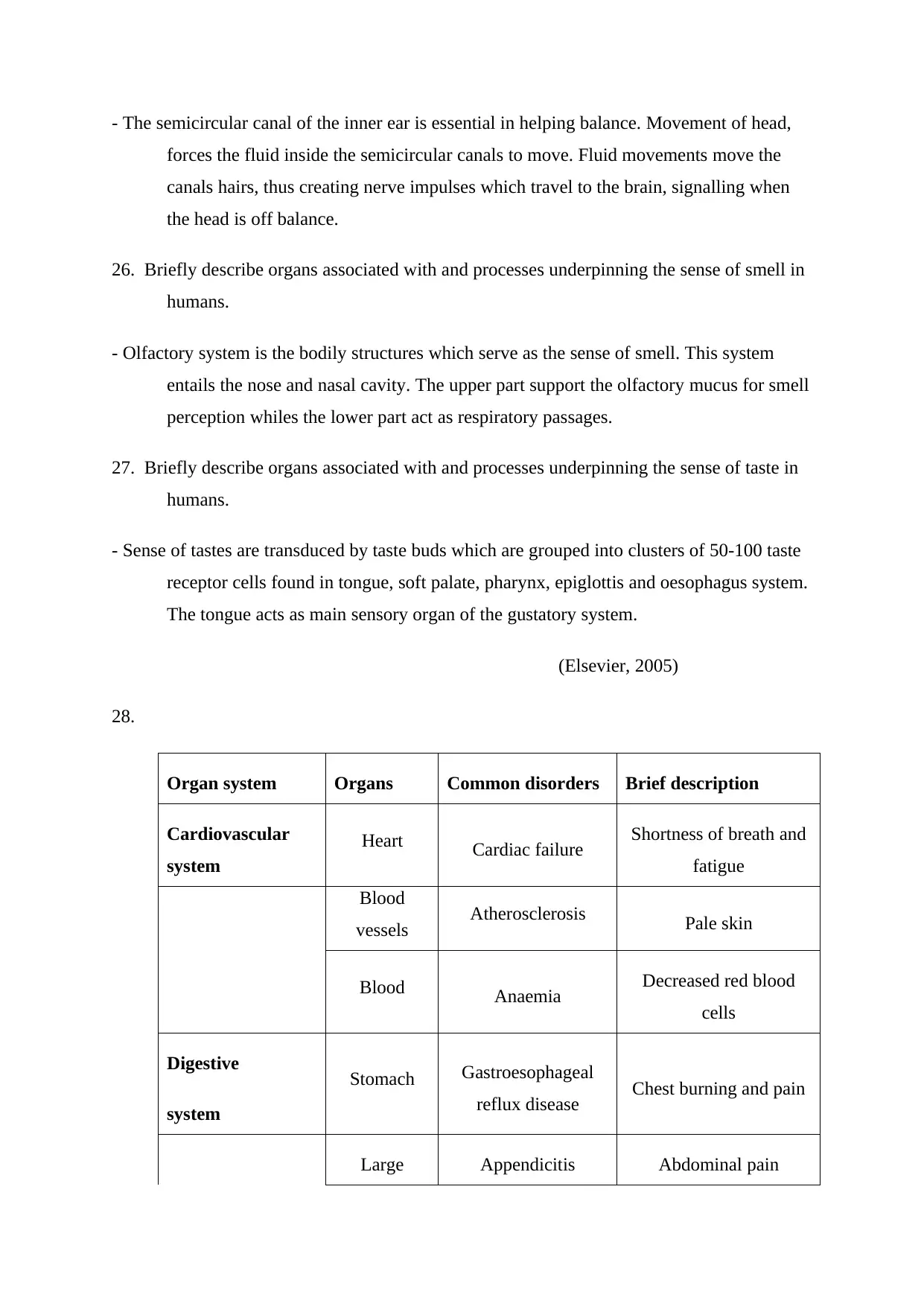
- The semicircular canal of the inner ear is essential in helping balance. Movement of head,
forces the fluid inside the semicircular canals to move. Fluid movements move the
canals hairs, thus creating nerve impulses which travel to the brain, signalling when
the head is off balance.
26. Briefly describe organs associated with and processes underpinning the sense of smell in
humans.
- Olfactory system is the bodily structures which serve as the sense of smell. This system
entails the nose and nasal cavity. The upper part support the olfactory mucus for smell
perception whiles the lower part act as respiratory passages.
27. Briefly describe organs associated with and processes underpinning the sense of taste in
humans.
- Sense of tastes are transduced by taste buds which are grouped into clusters of 50-100 taste
receptor cells found in tongue, soft palate, pharynx, epiglottis and oesophagus system.
The tongue acts as main sensory organ of the gustatory system.
(Elsevier, 2005)
28.
Organ system Organs Common disorders Brief description
Cardiovascular
system
Heart Cardiac failure Shortness of breath and
fatigue
Blood
vessels Atherosclerosis Pale skin
Blood Anaemia Decreased red blood
cells
Digestive
system
Stomach Gastroesophageal
reflux disease Chest burning and pain
Large Appendicitis Abdominal pain
forces the fluid inside the semicircular canals to move. Fluid movements move the
canals hairs, thus creating nerve impulses which travel to the brain, signalling when
the head is off balance.
26. Briefly describe organs associated with and processes underpinning the sense of smell in
humans.
- Olfactory system is the bodily structures which serve as the sense of smell. This system
entails the nose and nasal cavity. The upper part support the olfactory mucus for smell
perception whiles the lower part act as respiratory passages.
27. Briefly describe organs associated with and processes underpinning the sense of taste in
humans.
- Sense of tastes are transduced by taste buds which are grouped into clusters of 50-100 taste
receptor cells found in tongue, soft palate, pharynx, epiglottis and oesophagus system.
The tongue acts as main sensory organ of the gustatory system.
(Elsevier, 2005)
28.
Organ system Organs Common disorders Brief description
Cardiovascular
system
Heart Cardiac failure Shortness of breath and
fatigue
Blood
vessels Atherosclerosis Pale skin
Blood Anaemia Decreased red blood
cells
Digestive
system
Stomach Gastroesophageal
reflux disease Chest burning and pain
Large Appendicitis Abdominal pain
Paraphrase This Document
Need a fresh take? Get an instant paraphrase of this document with our AI Paraphraser
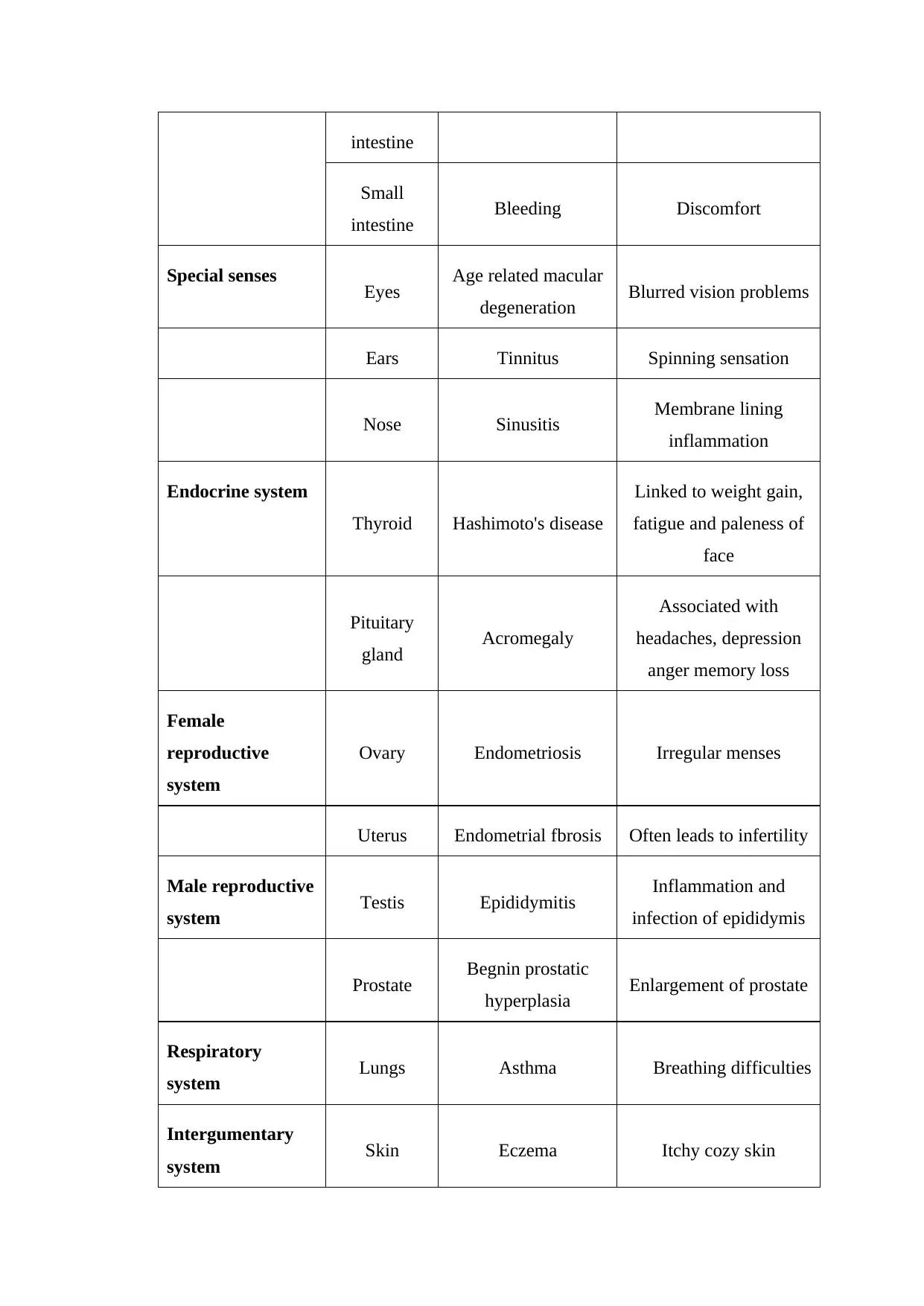
intestine
Small
intestine Bleeding Discomfort
Special senses Eyes Age related macular
degeneration Blurred vision problems
Ears Tinnitus Spinning sensation
Nose Sinusitis Membrane lining
inflammation
Endocrine system
Thyroid Hashimoto's disease
Linked to weight gain,
fatigue and paleness of
face
Pituitary
gland Acromegaly
Associated with
headaches, depression
anger memory loss
Female
reproductive
system
Ovary Endometriosis Irregular menses
Uterus Endometrial fbrosis Often leads to infertility
Male reproductive
system Testis Epididymitis Inflammation and
infection of epididymis
Prostate Begnin prostatic
hyperplasia Enlargement of prostate
Respiratory
system Lungs Asthma Breathing difficulties
Intergumentary
system Skin Eczema Itchy cozy skin
Small
intestine Bleeding Discomfort
Special senses Eyes Age related macular
degeneration Blurred vision problems
Ears Tinnitus Spinning sensation
Nose Sinusitis Membrane lining
inflammation
Endocrine system
Thyroid Hashimoto's disease
Linked to weight gain,
fatigue and paleness of
face
Pituitary
gland Acromegaly
Associated with
headaches, depression
anger memory loss
Female
reproductive
system
Ovary Endometriosis Irregular menses
Uterus Endometrial fbrosis Often leads to infertility
Male reproductive
system Testis Epididymitis Inflammation and
infection of epididymis
Prostate Begnin prostatic
hyperplasia Enlargement of prostate
Respiratory
system Lungs Asthma Breathing difficulties
Intergumentary
system Skin Eczema Itchy cozy skin

Nervous system Brain Alzeheimer disease Memory loss
Spinal cord Meningitis Sustained headache
Muscuoskeletal
system Bone osteoporosis Prone to fracture due to
agility
Muscles Duchenne muscular
dystrophy Weight gain and fatigue
Joint Arthritis Joints inflammation,
stiffness and swelling
Urinary Kidneys Chronic kidney
disease
Failure of complete
kidney function
Urinary
bladder Cystitis Bladder inflammation
Lymph
nodes and
vessels
Lymph nodes
enlargement
Lymph swelling due to
node blockage
Lymphatic system
Spleen Enlarged spleen
Linked to cirrhosis
infections and liver
diseases
29. Various health issues of mouth and teeth are listed below. Briefly describe the cause and
key features of these diseases.
a) Dental caries: Refers to breakdown of teeth due to acidic bacteria. The cavities can
discolour to various colours. Caries has been associated with poverty, poor hygiene
and receding of gums from the exposure on to tooth roots.
b) Periodontal disease: Also referred to as gum disease, represent a set f inflammatory state
affecting the gum tissue sin the tooth. The definitive symptoms are red, swollen and
Spinal cord Meningitis Sustained headache
Muscuoskeletal
system Bone osteoporosis Prone to fracture due to
agility
Muscles Duchenne muscular
dystrophy Weight gain and fatigue
Joint Arthritis Joints inflammation,
stiffness and swelling
Urinary Kidneys Chronic kidney
disease
Failure of complete
kidney function
Urinary
bladder Cystitis Bladder inflammation
Lymph
nodes and
vessels
Lymph nodes
enlargement
Lymph swelling due to
node blockage
Lymphatic system
Spleen Enlarged spleen
Linked to cirrhosis
infections and liver
diseases
29. Various health issues of mouth and teeth are listed below. Briefly describe the cause and
key features of these diseases.
a) Dental caries: Refers to breakdown of teeth due to acidic bacteria. The cavities can
discolour to various colours. Caries has been associated with poverty, poor hygiene
and receding of gums from the exposure on to tooth roots.
b) Periodontal disease: Also referred to as gum disease, represent a set f inflammatory state
affecting the gum tissue sin the tooth. The definitive symptoms are red, swollen and
⊘ This is a preview!⊘
Do you want full access?
Subscribe today to unlock all pages.

Trusted by 1+ million students worldwide
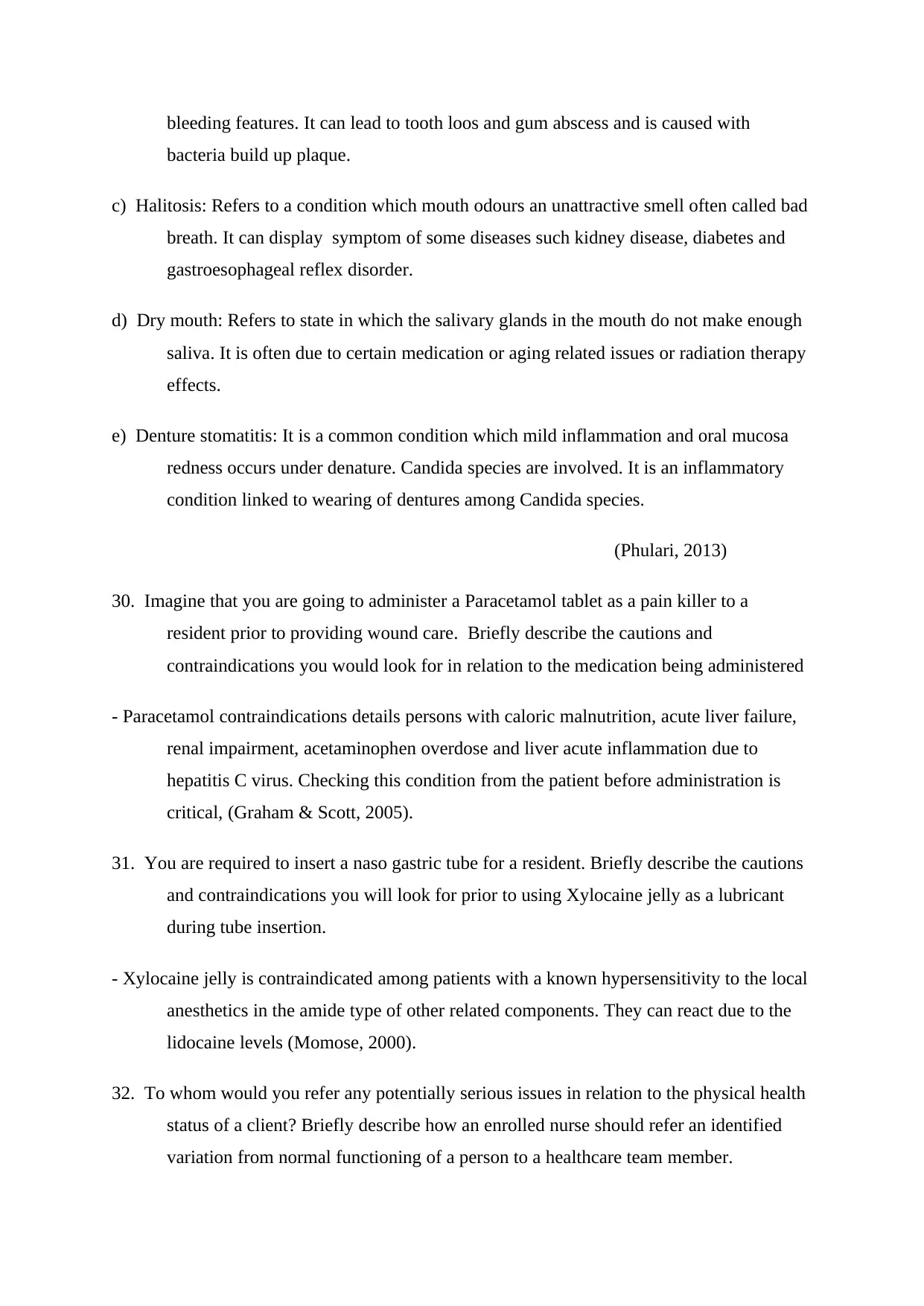
bleeding features. It can lead to tooth loos and gum abscess and is caused with
bacteria build up plaque.
c) Halitosis: Refers to a condition which mouth odours an unattractive smell often called bad
breath. It can display symptom of some diseases such kidney disease, diabetes and
gastroesophageal reflex disorder.
d) Dry mouth: Refers to state in which the salivary glands in the mouth do not make enough
saliva. It is often due to certain medication or aging related issues or radiation therapy
effects.
e) Denture stomatitis: It is a common condition which mild inflammation and oral mucosa
redness occurs under denature. Candida species are involved. It is an inflammatory
condition linked to wearing of dentures among Candida species.
(Phulari, 2013)
30. Imagine that you are going to administer a Paracetamol tablet as a pain killer to a
resident prior to providing wound care. Briefly describe the cautions and
contraindications you would look for in relation to the medication being administered
- Paracetamol contraindications details persons with caloric malnutrition, acute liver failure,
renal impairment, acetaminophen overdose and liver acute inflammation due to
hepatitis C virus. Checking this condition from the patient before administration is
critical, (Graham & Scott, 2005).
31. You are required to insert a naso gastric tube for a resident. Briefly describe the cautions
and contraindications you will look for prior to using Xylocaine jelly as a lubricant
during tube insertion.
- Xylocaine jelly is contraindicated among patients with a known hypersensitivity to the local
anesthetics in the amide type of other related components. They can react due to the
lidocaine levels (Momose, 2000).
32. To whom would you refer any potentially serious issues in relation to the physical health
status of a client? Briefly describe how an enrolled nurse should refer an identified
variation from normal functioning of a person to a healthcare team member.
bacteria build up plaque.
c) Halitosis: Refers to a condition which mouth odours an unattractive smell often called bad
breath. It can display symptom of some diseases such kidney disease, diabetes and
gastroesophageal reflex disorder.
d) Dry mouth: Refers to state in which the salivary glands in the mouth do not make enough
saliva. It is often due to certain medication or aging related issues or radiation therapy
effects.
e) Denture stomatitis: It is a common condition which mild inflammation and oral mucosa
redness occurs under denature. Candida species are involved. It is an inflammatory
condition linked to wearing of dentures among Candida species.
(Phulari, 2013)
30. Imagine that you are going to administer a Paracetamol tablet as a pain killer to a
resident prior to providing wound care. Briefly describe the cautions and
contraindications you would look for in relation to the medication being administered
- Paracetamol contraindications details persons with caloric malnutrition, acute liver failure,
renal impairment, acetaminophen overdose and liver acute inflammation due to
hepatitis C virus. Checking this condition from the patient before administration is
critical, (Graham & Scott, 2005).
31. You are required to insert a naso gastric tube for a resident. Briefly describe the cautions
and contraindications you will look for prior to using Xylocaine jelly as a lubricant
during tube insertion.
- Xylocaine jelly is contraindicated among patients with a known hypersensitivity to the local
anesthetics in the amide type of other related components. They can react due to the
lidocaine levels (Momose, 2000).
32. To whom would you refer any potentially serious issues in relation to the physical health
status of a client? Briefly describe how an enrolled nurse should refer an identified
variation from normal functioning of a person to a healthcare team member.
Paraphrase This Document
Need a fresh take? Get an instant paraphrase of this document with our AI Paraphraser
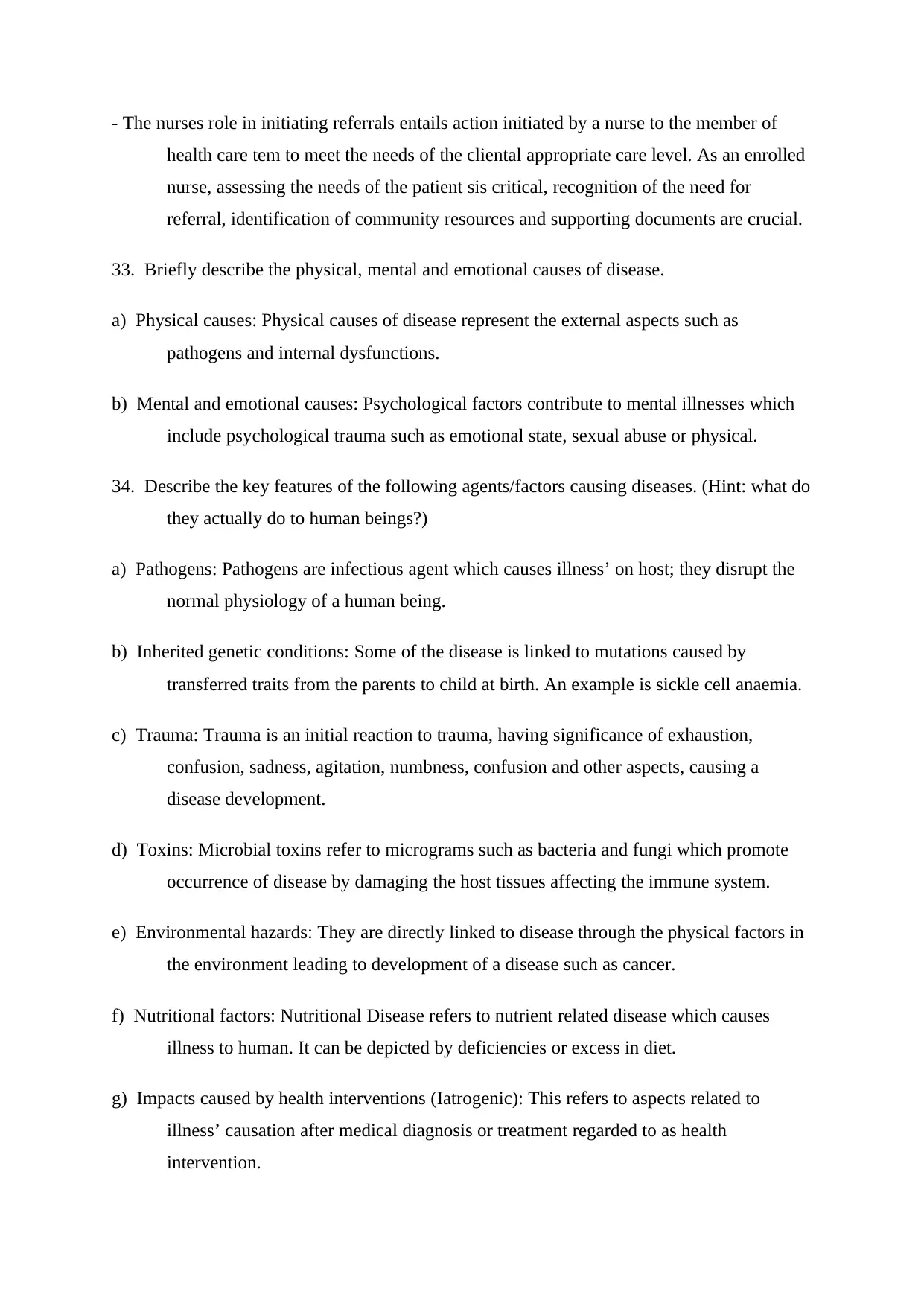
- The nurses role in initiating referrals entails action initiated by a nurse to the member of
health care tem to meet the needs of the cliental appropriate care level. As an enrolled
nurse, assessing the needs of the patient sis critical, recognition of the need for
referral, identification of community resources and supporting documents are crucial.
33. Briefly describe the physical, mental and emotional causes of disease.
a) Physical causes: Physical causes of disease represent the external aspects such as
pathogens and internal dysfunctions.
b) Mental and emotional causes: Psychological factors contribute to mental illnesses which
include psychological trauma such as emotional state, sexual abuse or physical.
34. Describe the key features of the following agents/factors causing diseases. (Hint: what do
they actually do to human beings?)
a) Pathogens: Pathogens are infectious agent which causes illness’ on host; they disrupt the
normal physiology of a human being.
b) Inherited genetic conditions: Some of the disease is linked to mutations caused by
transferred traits from the parents to child at birth. An example is sickle cell anaemia.
c) Trauma: Trauma is an initial reaction to trauma, having significance of exhaustion,
confusion, sadness, agitation, numbness, confusion and other aspects, causing a
disease development.
d) Toxins: Microbial toxins refer to micrograms such as bacteria and fungi which promote
occurrence of disease by damaging the host tissues affecting the immune system.
e) Environmental hazards: They are directly linked to disease through the physical factors in
the environment leading to development of a disease such as cancer.
f) Nutritional factors: Nutritional Disease refers to nutrient related disease which causes
illness to human. It can be depicted by deficiencies or excess in diet.
g) Impacts caused by health interventions (Iatrogenic): This refers to aspects related to
illness’ causation after medical diagnosis or treatment regarded to as health
intervention.
health care tem to meet the needs of the cliental appropriate care level. As an enrolled
nurse, assessing the needs of the patient sis critical, recognition of the need for
referral, identification of community resources and supporting documents are crucial.
33. Briefly describe the physical, mental and emotional causes of disease.
a) Physical causes: Physical causes of disease represent the external aspects such as
pathogens and internal dysfunctions.
b) Mental and emotional causes: Psychological factors contribute to mental illnesses which
include psychological trauma such as emotional state, sexual abuse or physical.
34. Describe the key features of the following agents/factors causing diseases. (Hint: what do
they actually do to human beings?)
a) Pathogens: Pathogens are infectious agent which causes illness’ on host; they disrupt the
normal physiology of a human being.
b) Inherited genetic conditions: Some of the disease is linked to mutations caused by
transferred traits from the parents to child at birth. An example is sickle cell anaemia.
c) Trauma: Trauma is an initial reaction to trauma, having significance of exhaustion,
confusion, sadness, agitation, numbness, confusion and other aspects, causing a
disease development.
d) Toxins: Microbial toxins refer to micrograms such as bacteria and fungi which promote
occurrence of disease by damaging the host tissues affecting the immune system.
e) Environmental hazards: They are directly linked to disease through the physical factors in
the environment leading to development of a disease such as cancer.
f) Nutritional factors: Nutritional Disease refers to nutrient related disease which causes
illness to human. It can be depicted by deficiencies or excess in diet.
g) Impacts caused by health interventions (Iatrogenic): This refers to aspects related to
illness’ causation after medical diagnosis or treatment regarded to as health
intervention.
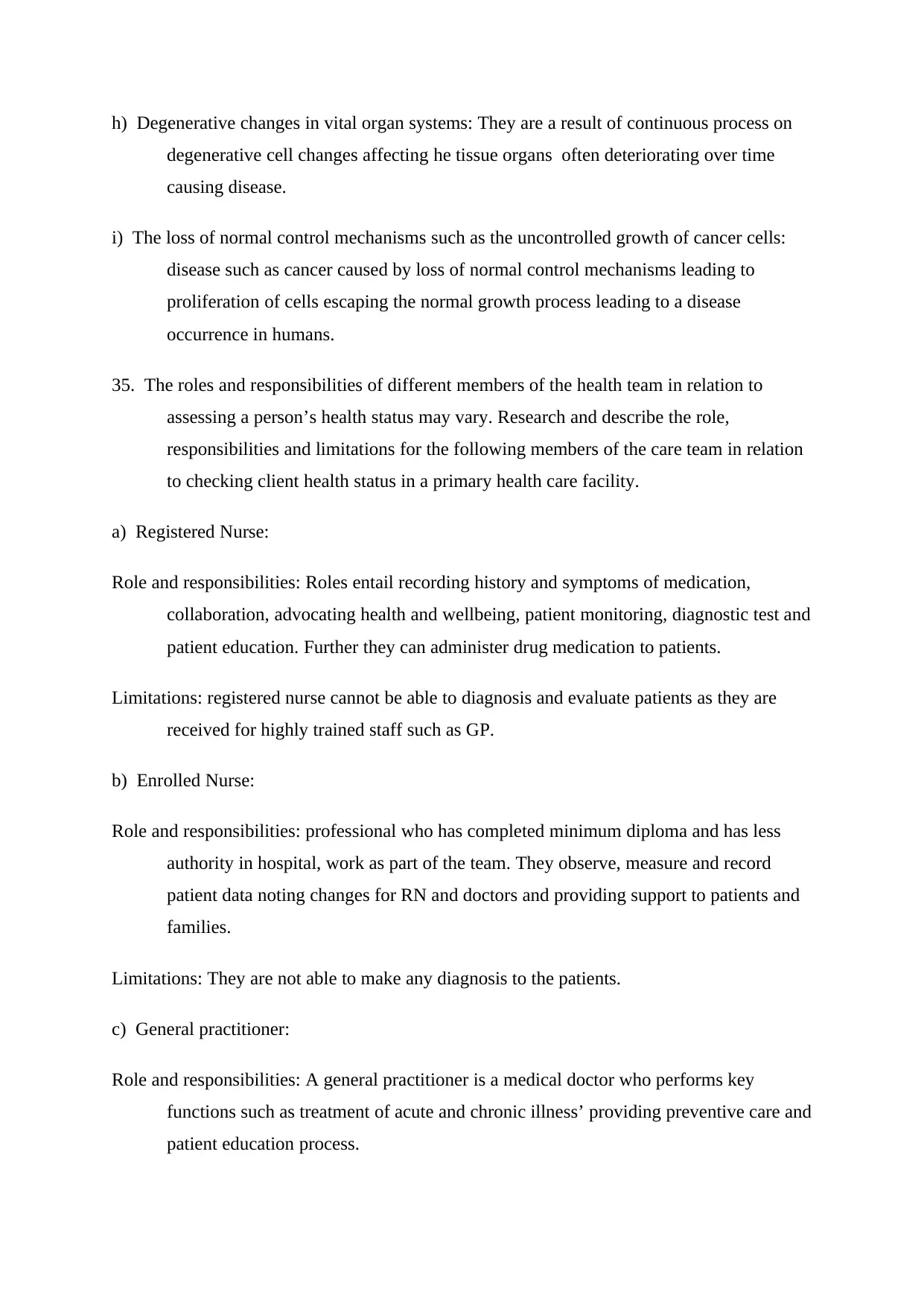
h) Degenerative changes in vital organ systems: They are a result of continuous process on
degenerative cell changes affecting he tissue organs often deteriorating over time
causing disease.
i) The loss of normal control mechanisms such as the uncontrolled growth of cancer cells:
disease such as cancer caused by loss of normal control mechanisms leading to
proliferation of cells escaping the normal growth process leading to a disease
occurrence in humans.
35. The roles and responsibilities of different members of the health team in relation to
assessing a person’s health status may vary. Research and describe the role,
responsibilities and limitations for the following members of the care team in relation
to checking client health status in a primary health care facility.
a) Registered Nurse:
Role and responsibilities: Roles entail recording history and symptoms of medication,
collaboration, advocating health and wellbeing, patient monitoring, diagnostic test and
patient education. Further they can administer drug medication to patients.
Limitations: registered nurse cannot be able to diagnosis and evaluate patients as they are
received for highly trained staff such as GP.
b) Enrolled Nurse:
Role and responsibilities: professional who has completed minimum diploma and has less
authority in hospital, work as part of the team. They observe, measure and record
patient data noting changes for RN and doctors and providing support to patients and
families.
Limitations: They are not able to make any diagnosis to the patients.
c) General practitioner:
Role and responsibilities: A general practitioner is a medical doctor who performs key
functions such as treatment of acute and chronic illness’ providing preventive care and
patient education process.
degenerative cell changes affecting he tissue organs often deteriorating over time
causing disease.
i) The loss of normal control mechanisms such as the uncontrolled growth of cancer cells:
disease such as cancer caused by loss of normal control mechanisms leading to
proliferation of cells escaping the normal growth process leading to a disease
occurrence in humans.
35. The roles and responsibilities of different members of the health team in relation to
assessing a person’s health status may vary. Research and describe the role,
responsibilities and limitations for the following members of the care team in relation
to checking client health status in a primary health care facility.
a) Registered Nurse:
Role and responsibilities: Roles entail recording history and symptoms of medication,
collaboration, advocating health and wellbeing, patient monitoring, diagnostic test and
patient education. Further they can administer drug medication to patients.
Limitations: registered nurse cannot be able to diagnosis and evaluate patients as they are
received for highly trained staff such as GP.
b) Enrolled Nurse:
Role and responsibilities: professional who has completed minimum diploma and has less
authority in hospital, work as part of the team. They observe, measure and record
patient data noting changes for RN and doctors and providing support to patients and
families.
Limitations: They are not able to make any diagnosis to the patients.
c) General practitioner:
Role and responsibilities: A general practitioner is a medical doctor who performs key
functions such as treatment of acute and chronic illness’ providing preventive care and
patient education process.
⊘ This is a preview!⊘
Do you want full access?
Subscribe today to unlock all pages.

Trusted by 1+ million students worldwide
1 out of 15
Related Documents
Your All-in-One AI-Powered Toolkit for Academic Success.
+13062052269
info@desklib.com
Available 24*7 on WhatsApp / Email
![[object Object]](/_next/static/media/star-bottom.7253800d.svg)
Unlock your academic potential
Copyright © 2020–2025 A2Z Services. All Rights Reserved. Developed and managed by ZUCOL.





